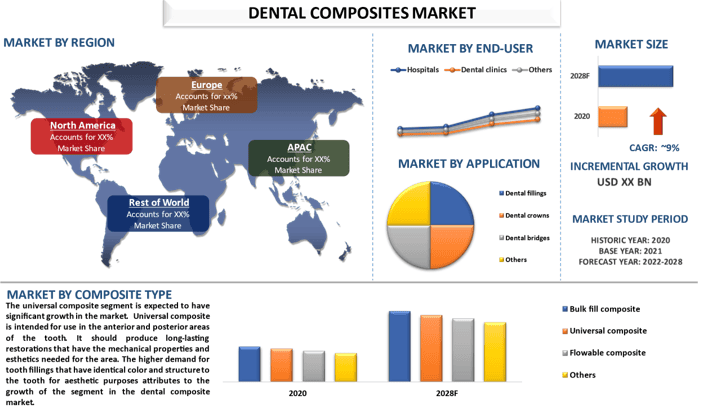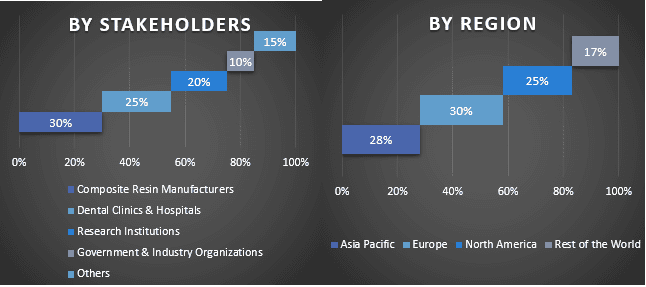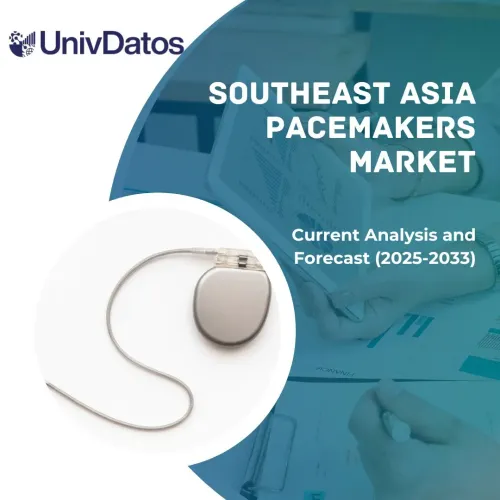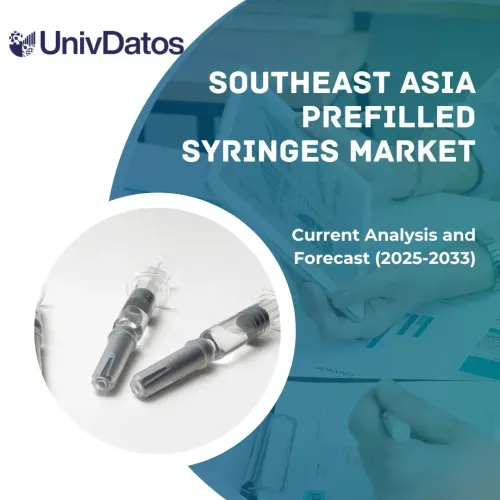- Home
- About Us
- Industry
- Services
- Reading
- Contact Us
Dental Composites Market: Current Analysis and Forecast (2022-2028)
Emphasis on Composite Type (Bulk Fill Composite, Universal Composite, Flowable Composite, and Others); Application (Dental Fillings, Dental Crowns, Dental Bridges, and Others); End-User (Hospitals, Dental Clinics, and Others); and Region/Country

The global dental composites market is expected to grow at a significant rate of around 9% during the forecast period. The global dental composites market is anticipated to witness an uptick with the development of social society leading to changes in diet and other lifestyles. This along with the rapidly growing geriatric population across the globe is leading to an increased incidence of dental caries or tooth decay. Furthermore, the growth of the dental composites market can be also attributed to the growing adoption of tobacco and smoking which can cause detrimental effects on dental health leading to an increase in the prevalence of dental problems. For instance, according to the Centers for Disease Control and Prevention, people who smoke have untreated tooth decay. Almost 40% of adults aged 20 to 64 who currently smoke cigarettes have untreated tooth decay. Also, nearly 43% of adults aged 65 or older who currently smoke cigarettes have lost all their teeth.
BISCO Inc., COLTENE Group, DMG America LLC, Envista Holdings Corporation, 3M, SDI Limited, Tokuyama Dental America Inc., Ultradent Products Inc, VOCO GmbH, Zest Dental Solutions are some of the key players in the market. Several M&As along with partnerships have been undertaken by these players to facilitate customers with hi-tech and innovative products/technologies.
Insights Presented in the Report
“Amongst Composite Type, universal composite category to witness higher CAGR during the forecast period”
Based on the composite type, the market has been categorized into bulk fill composite, universal composite, flowable composite, and others. Among them, the universal composite segment is expected to have significant growth in the market. Universal composite is intended for use in the anterior and posterior areas of the tooth. It should produce long-lasting restorations that have the mechanical properties and esthetics needed for the area. The higher demand for tooth fillings that have identical color and structure to the tooth for aesthetic purposes attributes to the growth of the segment in the dental composite market.
“Amongst Application, universal composite category to witness higher CAGR during the forecast period”
Based on application, the market has been categorized into dental fillings, dental crowns, dental bridges, and others. Among them, the dental filling segment is expected to hold a higher CAGR in the market during the forecast period. Dental fillings are used in the treatment of various dental conditions such as cracked teeth and tooth decay, the increased prevalence of these conditions is attributed to the rising demand for tooth fillings. For instance, the prevalence of cracked teeth is around 80% in patients over 40 years of age. The incidence of incomplete tooth fracture with vital pulps is 9.7%.
“Amongst End-user, healthcare segment to hold a significant share in the market in 2020”
Based on end-users, the market is fragmented into hospitals, dental clinics, and others. In 2020, the dental clinic segment grabbed a considerable market share, and it is expected to grow at a significant CAGR during the forecast period. This can be due to an increased preference of patients to get treatment in dental clinics owing to the presence of skilled healthcare professionals, availability of technologically advanced equipment, and a well-established & robust infrastructure.
“North America to hold a significant share in the market”
For a better understanding of the market adoption of the Dental Composites industry, the market is analyzed based on its worldwide presence in the countries such as North America (United States, Canada, and the Rest of North America), Europe (Germany, France, Italy, Spain, United Kingdom and Rest of Europe), Asia-Pacific (China, Japan, India, Australia, and Rest of APAC), and Rest of World. In 2020, North America is anticipated to grow at a substantial CAGR during the forecast period. The major factors such as the growing prevalence of oral diseases and the well-established healthcare infrastructure in the region. Furthermore, the rapidly increasing geriatric population and the presence of key market players in the region are also some of the prominent factors contributing to the market growth. For instance, the number of Americans aged 60 and older increased by 34% from 55.7 million to 74.6 million between 2009 and 2019.
Reasons to buy this report:
- The study includes market sizing and forecasting analysis validated by authenticated key industry experts.
- The report presents a quick review of overall industry performance at one glance.
- The report covers an in-depth analysis of prominent industry peers with a primary focus on key business financials, product portfolio, expansion strategies, and recent developments.
- Detailed examination of drivers, restraints, key trends, and opportunities prevailing in the industry.
- The study comprehensively covers the market across different segments.
- Deep dive regional level analysis of the industry.
Customization Options:
The global Dental Composites market can further be customized as per the requirement or any other market segment. Besides this, UMI understands that you may have your own business needs, hence feel free to connect with us to get a report that completely suits your requirements.
Table of Content
Research Methodology for the Dental Composites Market Analysis (2022-2028)
Analyzing the historical market, estimating the current market, and forecasting the future market of the global Dental Composites market were the three major steps undertaken to create and analyze the adoption of dental composites in major regions globally. Exhaustive secondary research was conducted to collect the historical market numbers and estimate the current market size. Secondly, to validate these insights, numerous findings and assumptions were taken into consideration. Moreover, exhaustive primary interviews were also conducted, with industry experts across the value chain of the global Dental Composites market. Post assumption and validation of market numbers through primary interviews, we employed a top-down/bottom-up approach to forecasting the complete market size. Thereafter, market breakdown and data triangulation methods were adopted to estimate and analyze the market size of segments and sub-segments of the industry pertains to. Detailed methodology is explained below:
Analysis of Historical Market Size
Step 1: In-Depth Study of Secondary Sources:
Detail secondary study was conducted to obtain the historical market size of the dental composites market through company internal sources such as annual reports & financial statements, performance presentations, press releases, etc., and external sources including journals, news & articles, government publications, competitor publications, sector reports, third-party database, and other credible publications.
Step 2: Market Segmentation:
After obtaining the historical market size of the Dental Composites market, we conducted a detailed secondary analysis to gather historical market insights and share for different segments & sub-segments for major regions. Major segments are included in the report as composite type, application, and end-user. Further country-level analyses were conducted to evaluate the overall adoption of testing models in that region.
Step 3: Factor Analysis:
After acquiring the historical market size of different segments and sub-segments, we conducted a detailed factor analysis to estimate the current market size of the dental composites market. Further, we conducted factor analysis using dependent and independent variables such as the composite type, application, and end-user of Dental Composites. A thorough analysis was conducted for demand and supply-side scenarios considering top partnerships, mergers and acquisitions, business expansion, and product launches in the Dental Composites market sector across the globe.
Current Market Size Estimate & Forecast
Current Market Sizing: Based on actionable insights from the above 3 steps, we arrived at the current market size, key players in the global Dental Composites market, and market shares of the segments. All the required percentage shares split, and market breakdowns were determined using the above-mentioned secondary approach and were verified through primary interviews.
Estimation & Forecasting: For market estimation and forecast, weights were assigned to different factors including drivers & trends, restraints, and opportunities available for the stakeholders. After analyzing these factors, relevant forecasting techniques i.e., the top-down/bottom-up approach were applied to arrive at the market forecast for 2028 for different segments and sub-segments across the major markets globally. The research methodology adopted to estimate the market size encompasses:
- The industry’s market size, in terms of revenue (USD) and the adoption rate of the dental composites market across the major markets domestically
- All percentage shares, splits, and breakdowns of market segments and sub-segments
- Key players in the global Dental Composites market in terms of products offered. Also, the growth strategies adopted by these players to compete in the fast-growing market
Market Size and Share Validation
Primary Research: In-depth interviews were conducted with the Key Opinion Leaders (KOLs) including Top Level Executives (CXO/VPs, Sales Head, Marketing Head, Operational Head, Regional Head, Country Head, etc.) across major regions. Primary research findings were then summarized, and statistical analysis was performed to prove the stated hypothesis. Inputs from primary research were consolidated with secondary findings, hence turning information into actionable insights.
Split of Primary Participants in Different Regions

Market Engineering
The data triangulation technique was employed to complete the overall market estimation and to arrive at precise statistical numbers for each segment and sub-segment of the global dental composites market. Data was split into several segments & sub-segments post studying various parameters and trends in the areas of the application and product type in the global Dental Composites market.
The main objective of the Global Dental Composites Market Study
The current & future market trends of the global dental composites market were pinpointed in the study. Investors can gain strategic insights to base their discretion for investments on the qualitative and quantitative analysis performed in the study. Current and future market trends determined the overall attractiveness of the market at a regional level, providing a platform for the industrial participant to exploit the untapped market to benefit from a first-mover advantage. Other quantitative goals of the studies include:
- Analyze the current and forecast market size of the dental composites market in terms of value (USD). Also, analyze the current and forecast market size of different segments and sub-segments
- Segments in the study include areas of the composite type, application, and end-user.
- Define and analysis of the regulatory framework for the dental composites industry.
- Analyze the value chain involved with the presence of various intermediaries, along with analyzing customer and competitor behaviors of the industry.
- Analyze the current and forecast market size of the dental composites market for the major region.
- Major countries of regions studied in the report include Asia Pacific, Europe, North America, and the Rest of the World.
- Company profiles of the dental composites market and the growth strategies adopted by the market players to sustain in the fast-growing market
Deep dive regional level analysis of the industry
Related Reports
Customers who bought this item also bought










